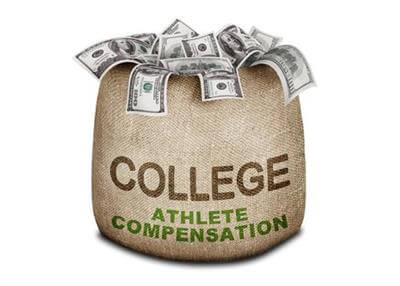What Would Paying College Athletes Actually Look Like?

The argument over compensating college athletes has been raging for decades; and in the year 2016, it seems to be as relevant as ever.
Some argue that athletes are rightly compensated with free college tuition and the opportunity to further their education. Others argue that schools and the NCAA pull in huge profits from their football and basketball programs and should reward the players responsible for the endless cash flow.
But what would paying college athletes actually look like? Let’s look at some of the key issues surrounding the argument:
How much are college athletes going to be paid?
First and foremost, how much would college players be paid and what does the compensation structure look like? Would the compensation be based on individual performance, as in the pros, or would it be school or program based?
If payments are program based, the problem becomes fairness, as the top athletes in field hockey and lacrosse are guaranteed to make less than the second stringers on the football team simply because the football team brings in more money. Larger programs — typically football and basketball — are often the cash cow for the rest of the school’s teams, so the money they allocate to player salaries would have a major impact on the athletic department’s ability to support smaller sports.
And if it’s based on performance, how do you compare athletes’ abilities across different sports? This also creates a scenario where bidding wars occur for high school athletes…
How does this affect the recruiting process?
Paying NCAA athletes would create a ripple effect throughout high school and youth sports, as the processes for recruiting, college selection and even sport selection would drastically change.
With certain schools paying athletes more than others, coaches at high profile programs would have the ultimate recruiting tool, giving them a major advantage over smaller schools. The major conferences would be able to create a monopoly — or at least, more of a monopoly — over the top tier talent, as smaller conferences and division II and III schools would be left to recruit players who won’t garner large salaries.
And how would this change the thought process and decision making of student athletes? The choice of sport and school would now have to factor in earning potential. While most athletes know their chances of going pro are slim, there would be countless opportunities to capitalize on their athletic abilities in college. That means young athletes choosing a particular sport over another, simply because there is potential for higher compensation.
Signing Day would really take on a whole new meaning.
Would college athletes need to unionize?
As mentioned earlier, the compensation structure for college athletes is the largest obstacle in all this, as there is no fair way to determine how athletes should be paid. And that means college athletes would need to unionize.
But becoming unionized brings its own set of issues. Unions require fees and administrators; who would be responsible for paying dues and holding elections? Remember, college athletes are fresh out of high school and typically still dependent on their parents or guardians for income. And with so much turnover in college sports, new union representatives would need to be elected annually, meaning little cohesion year-to-year.
Making it even more difficult, a precedent has already been set. Last year, the National Labor Relations Board denied an attempt by Northwestern University’s football players to unionize, as they declared that the players weren’t employees of the university.
But the argument rages on.
Should college athletes be paid? The answer may not be so simple, as there are many hurdles in the way. What’s your opinion? Leave it in the comments.






